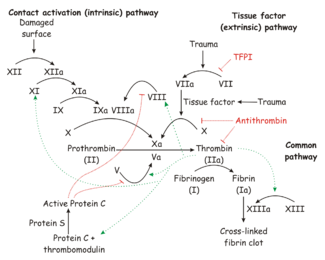Coagulation Factor Deficiency
Introduction
Factor deficiencies are often the result of congenital deficiency in one or more of the coagulation factors. Deficiencies lead to ineffective blood clotting and development of a disease syndrome characterized by excessive bleeding - deficiencies are often detected following trauma or surgery. Occasionally bleeding may be spontaneous (e.g. into alimentary or urinary tracts). Deficiencies are often seen as familial inherited problems. Haemophilia (factor VIII deficiency) is probably the best understood condition.
Von Willebrand's Disease
This condition is seen in the dog, most frequently in Scottish Terriers and Chesapeake Bay Retrievers. It has become more prevalent recently in Dobermanns, Setters and German Shepherd dogs. A similar disease has been recorded in the pig.
Von Willebrand's Disease is an inherited autosomal recessive trait. It is incompletely dominant, so there is variable expression. It can present as purpura and/or prolonged bleeding times. Pathologically, there is reduced platelet adhesiveness and low Factor XIII levels.
The disease can be assessed by the measurement of Von Willebrand Factor protein levels; levels are low in affected animals. The Von Willebrand Factor protein bind to Factor VIII, and is synthesised in endothelial cells and megakaryocytes and stored in platelets.
Factor I
Factor 1 is fibrinogen.
Hyperfibrinogenaemia occurs in:
- Pregnancy
- Acute infections
- Post-operative states
- Pyometra
Hypofibrinogenaemia is seen in:
- Liver disease.
- disseminated intravascular coagulation (DIC).
Factor II
Factor II is part of the prothrombin complex. Hypoprothrombinaemia occurs when there is a lack of the components of the prothrombin complex - factors II, VII, IX, X. This can be caused by dicoumarol and its derivatives, as found in sweet clover and warfarin, which competitively inhibit Vitamin K activity in the liver, where the factors are synthesised.
Factor IV
Factor IV is calcium, which is necessary at several stages of coagulation. Hypocalcaemia at a level sufficient to impair haemostasis is incompatible with life.
Factor VII
Factor VII is Proconvertin; deficiencies of factor VII do not appear to impair the formation of the haemostatic plug and any resulting bleeding defect is normally mild. Newborn pups have a very low plasma level of Factor VII and spontaneous and inherited deficiencies have been reported in Beagle colonies. Deficiencies may also occur associated with liver disease and in dicoumarol poisoning.
Factor VIII
Factor VIII is known as antihaemophilic factor (AHF); a deficiency of this factor causes haemophilia A. In haemophilic conditions:
- The primary thrombocyte plug is abnormal with more vascular channels than usual and less fibrin-collagen contact around the edges.
- Plugs are therefore easily dislodged which results in rebleeding.
- Secondary plugs only form with difficulty.
Haemophilia is reported in horses and in around 20 breeds of dogs - it is known to be a sex-linked recessive condition associated with the X chromosome which affects only males.
The severity of the disease correlates with the Factor VIII levels. Haematomas and haemarthrosis are commonly seen as a result of this condition.
Factor IX
Factor IX is 'Christmas Factor' and deficiency causes haemophilia B. This occurs presominantly in Cairn Terriers and Black and Tan Hounds. It is similar to Factor VIII deficiency; a sex-linked (X chromosome) recessive that results in a deficient haemostatic plug.
Factor XI
Factor XI is an antecedent to plasma Thromboplastin. Deficiencies have been reported in the cow, and reduced levels have been reported in the horse.
Factor XII
Factor XII is known as 'Hageman Factor'; low plasma levels had been reported in cats and horses.
| Coagulation Factor Deficiency Learning Resources | |
|---|---|
To reach the Vetstream content, please select |
Canis, Felis, Lapis or Equis |
